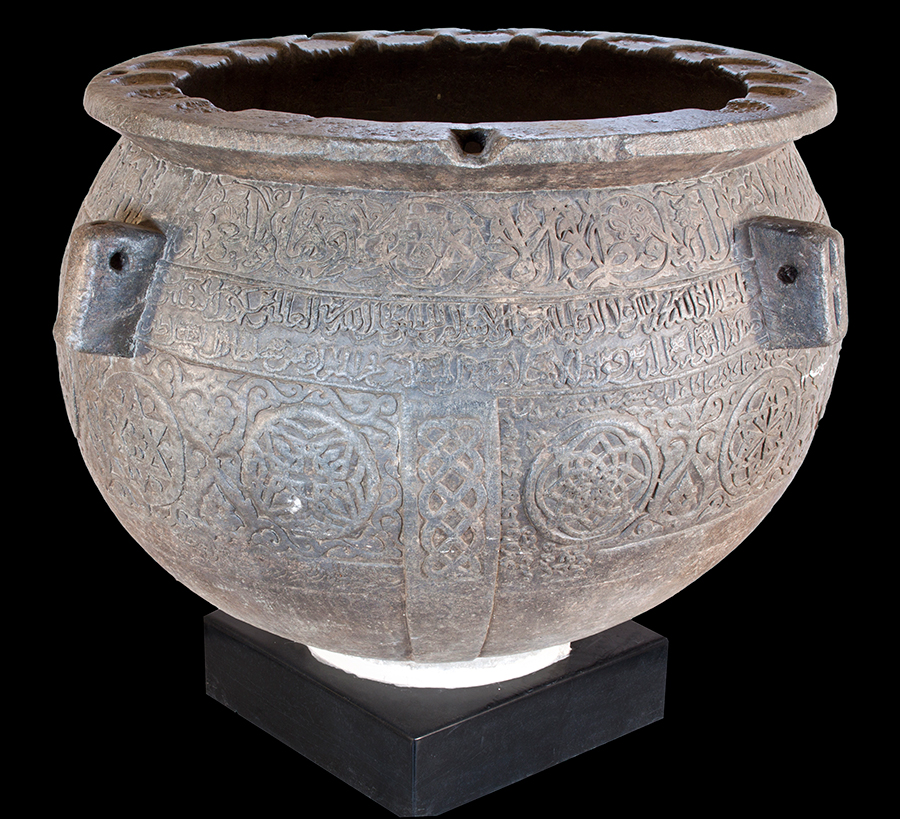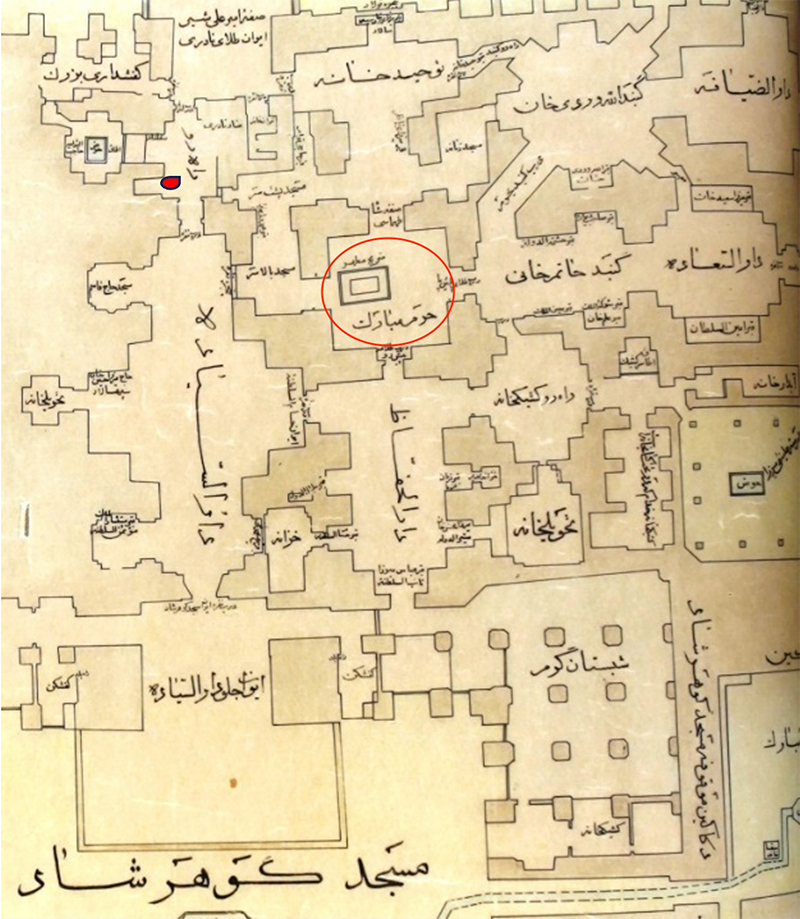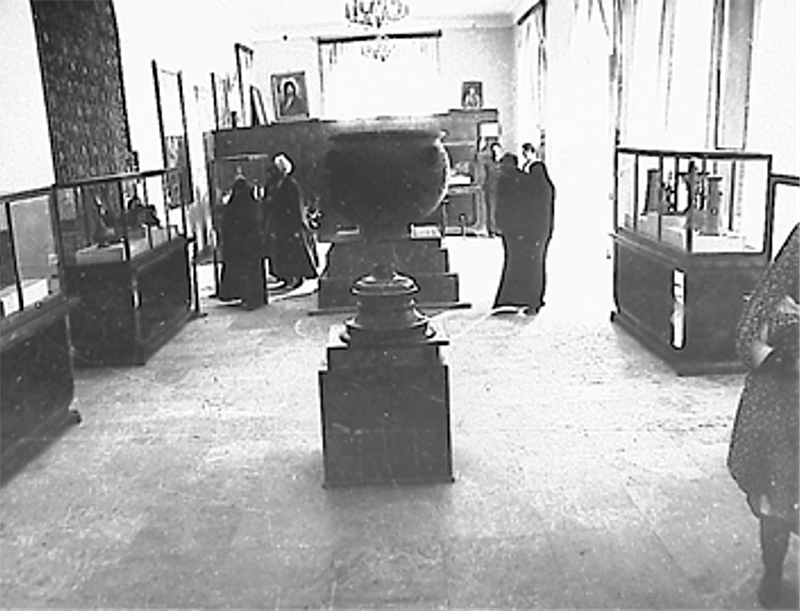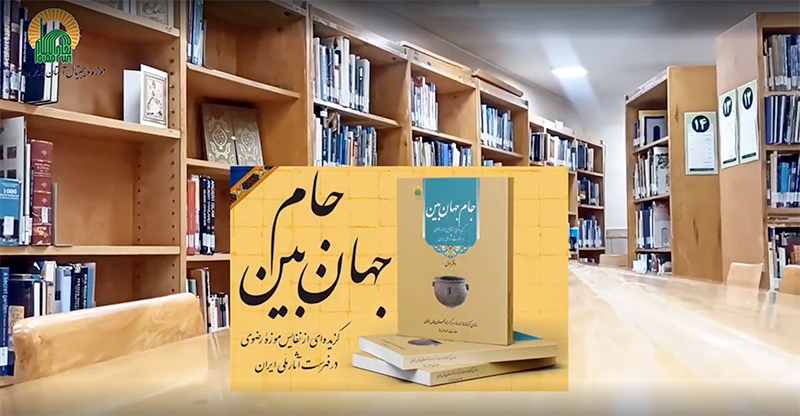*This is an English translation of the original catalog entry in Persian
21Basin (sangab) for the Shrine of Emam Reza (AS) at Mashhad

Iran, Kharazmshahi period, 1200–13 Black serpentine H. 3.6 ft. × D. 4.49 ft. (H. 110 × D. 137 cm) Astan-e Qods-e Razavi Museum, Mashhad, no. 21 Photograph ©︎ Organization of Libraries, Museums and Documents Center of Astan-e Qods-e Razavi
Large stone basins (سنگاب, sangab) were commonly installed at the entrances and sometimes within the courtyards of mosques, schools, and other religious sites. They were used by people to drink water and perform ablutions. This basin was carved from a single piece of black serpentine stone (هرکاره, harakareh) and, due to its function, was also known as a saqakhaneh (سقاخانه, a public water dispenser). It is a valuable and unique example of the stone carving art of the Kharazmshahi period (خوارزمشاهی, ca. 1077–1231) and adorned with decorative floral and geometric patterns and inscriptions bearing names of individuals. It remained at the entrance to the holy shrine of Emam Reza (AS) from the time of its installation until before 1939 (fig. 1).

The inscriptions on the upper row of the basin, written in sols (ثلث, thuluth) script and intertwined with intricate arabesque designs, include religious anecdotes (روایات), words of wisdom, and the name of the patron (fig. 2). The second row contains the name and titles of Soltan Mohammad Kharazmshah (r. 1200–20) and his minister Mohammad b. Masʿud. The decorations on the body of the basin consist of four rectangular frames, each adorned with three shamseh (شمسه, sun-shaped) motifs and separated from the others by a decorative band. Some of the frames are decorated with intricate knotwork, while others contain inscriptions in roqaʿ (رقاع) script, including the names of the maker and designer and supplicatory phrases. The spaces between these frames are adorned with arabesque designs.

The production of this piece began in 1200, and it was commissioned by Mohammad b. Heydar Musavi, designed by Masʿud Naqqash Hazrati, and crafted by two stonemasons (سنگتراش), Ahmad and Mohammad. After the death of Ostad Ahmad sangtarash in 610/1213–14, Mohammad b. Ahmad and his other sons completed the work. Soltan Mohammad Kharazmshah and his minister Mohammad b. Masʿud are also mentioned throughout the inscriptions with great respect and multiple titles, as a sign of honor (Kafili, “Sangab-e Kharazmshahi,” p. 58–59).
Between 1939 and 1943, Dr. Mehdi Bahrami prepared this basin for transfer to the Astan-e Qods-e Razavi Museum (موزهی آستان قدس رضوی), where it was displayed in its first exhibition (fig. 3). Today, this basin is on display in the main entrance hall of the museum, located just off the sahn-e Kowsar (Kowsar courtyard) (map) (vids. 1–2). The Astan-e Qods-e museum complex consists of four museums: the Central Museum, Carpet Museum, Qur’an and Rare Objects Museum, and Anthropology Museum (to the west in the Mehdi Qoli Beyg Bathhouse, map).

Video 1. The Kowsar courtyard and entrance of the Astan-e Qods-e Razavi Museum (map), Shrine of Emam Reza, Mashhad. Video by Sakineh Yousefi, Astan Qods-e Razavi Digital Museum, 2023.
Video 2. Entrance of the museum. Video by Sakineh Yousefi, Astan Qods-e Razavi Digital Museum, 2023.
Video 3: The basin in the entrance hall of the museum. Video by Sakineh Yousefi, Astan Qods-e Razavi Digital Museum, 2023.
An image of this basin appears on the cover of my recent book about the outstanding objects in the Astan-e Qods-e Razavi Museum (fig. 4). For more information about this book, please refer to this video (in Persian).

Sources:
- بینش، تقی. «سنگاب خوارزمشاهی.» نامه آستان قدس، شمارهی ۳۸ (۱۳۴۷ش.): ۷۵-۱۰۸. [Binesh, “Sangab-e Kharazmshahi”] [Noormags.ir]
- سیدی، مهدی و حشمت کفیلی. «سنگاب خوارزمشاهی.» در دائرة المعارف آستان قدس رضوی، جلد اول (آ- س). مشهد: بنیاد پژوهشهای اسلامی، ۱۳۹۳ش. [Seyyedi and Kafili, “Sangab-e Kharazmshahi”]
- کفیلی، حشمت. «سنگاب خوارزمشاهی.» ﻭﻗﻒ ﻣﯿﺮﺍﺙ ﺟﺎﻭﯾﺪﺍﻥ، شمارهی ۴۱ و ۴۲ (ﺑﻬﺎﺭ ﻭ ﺗﺎﺑﺴﺘﺎﻥ ۱۳۸۲ش.): ۵۳-۶۰. [Kafili, “Sangab-e Kharazmshahi”] [SID.ir]
- کفیلی، حشمت. جام جهانبین: گزیدهای از نفایس موزه رضوی در فهرست آثار ملی ایران، تهران: پژوهشگاه میراث فرهنگی کشور با همکاری سازمان کتابخانهها، موزهها و مرکز اسناد آستان قدس رضوی، ۱۴۰۳ش. [Kafili, “Jam-e Jahanbin”]
- کفیلی، حشمت، مریم حبیبی و محمدرضا شاهرودیزاده. موزههای آستان قدس رضوی، تهران: پژوهشگاه میراث فرهنگی کشور با همکاری سازمان کتابخانهها، موزهها و مرکز اسناد آستان قدس رضوی، ۱۳۹۶ش. [Kafili et al., “Muzeh-ha-ye Astan-e Qods-e Razavi”]
Citation: Heshmat Kafili, “Basin (sangab) for the Shrine of Emam Reza (AS) at Mashhad,” translated by Hoda Nedaeifar. Catalog entry in The Emamzadeh Yahya at Varamin: An Online Exhibition of an Iranian Shrine, directed and edited by Keelan Overton. 33 Arches Productions, January 15, 2025. Host: Khamseen: Islamic Art History Online.
